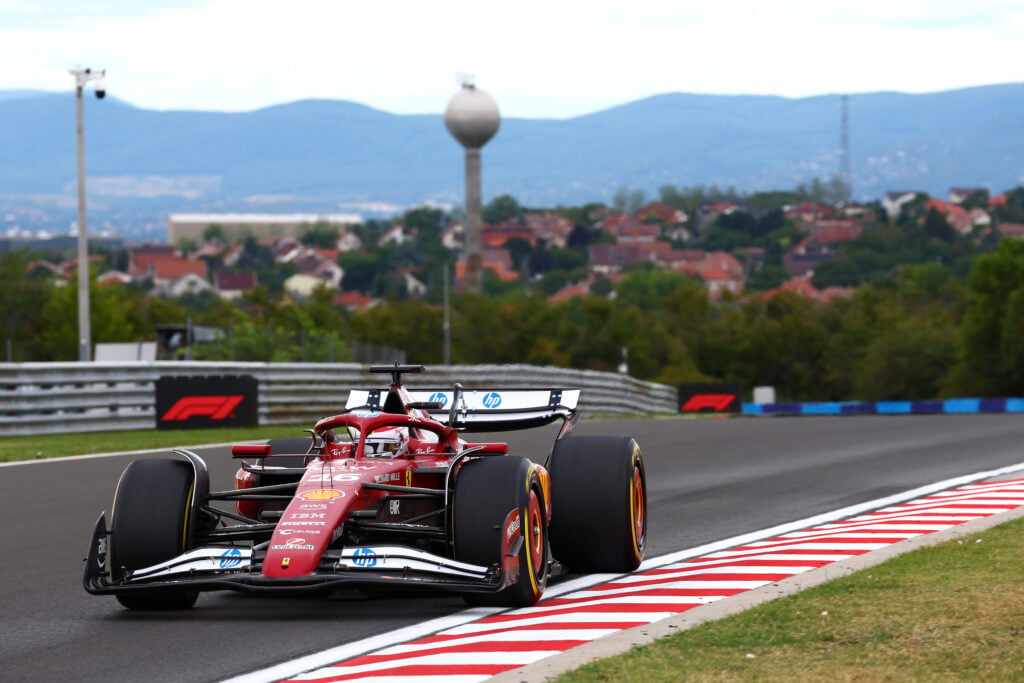Ferrari star Charles Leclerc hung around after a miserable end to his Hungarian Grand Prix to take part in the Pirelli 2026 tyre test, and he may have also realised an F1 first.
Pirelli hired the Hungaroring for a two-day test of the C3, C4 and C5 tyres that it is preparing for the 2026 F1 regulations. As well as the new engine, chassis and aerodynamic regulations due next season, Pirelli’s 2026 tyres will be 25mm and 30mm narrower at the front and rear.
Alpine reserve driver Paul Aron set the fastest lap of Pirelli’s 2026 F1 tyre test in Hungary on Tuesday with a 1:18.789. McLaren’s Lando Norris penned a 1:19.272 and Racing Bulls’ Liam Lawson set a 1:19.510, before Leclerc set a 1:19.407 during a qualifying sim on Wednesday.
Leclerc drove a modified version of his Ferrari SF-25 to simulate the loads of the 2026 rules on the Pirelli tyres. He also conducted the bulk of the race simulations on Wednesday, after Alpine driver Franco Colapinto crashed during Pirelli’s 2026 F1 tyre test amid the short runs.
 Photo by Joe Portlock/Getty ImagesFerrari used Pirelli’s 2026 tyre test to experiment with active aerodynamics on a front wing
Photo by Joe Portlock/Getty ImagesFerrari used Pirelli’s 2026 tyre test to experiment with active aerodynamics on a front wing
Ferrari also took advantage of F1 and the FIA allowing teams taking part in Pirelli’s 2026 tyre tests to install an activator to test an active front wing. The 2026 regulations will see F1 cars use active aerodynamics for the first time to help manage the power from the new engines.
READ MORE: Everything you need to know about F1’s 2026 engine and chassis regulations
TEAMENGINERed BullRed Bull Powertrains (in partnership with Ford)FerrariFerrariMcLarenMercedesMercedesMercedesAston MartinHondaRacing BullsRed Bull Powertrains (in partnership with Ford)HaasFerrariWilliamsMercedesAlpineMercedesAudiAudiCadillacFerrariF1 engine suppliers for the 2026 season
According to Motorsport.com, Ferrari were likely the first team through Leclerc to sample an active front wing on a modified version of an existing car. Most teams have chosen not to try designs on a mule car, as they will have little in common with the final designs used in 2026.
Ferrari, though, saw Pirelli’s tyre test at the Hungaroring as their chance to experiment. The pride of Italy moved the height adjuster on their front wing from the outside of the last flap element to the inside, with a presumably hydraulically operated manual system for Leclerc.
Charles Leclerc will hope Ferrari are on the right course with their 2026 rules engine
While rival teams focused on investing their resources elsewhere, Ferrari wanted to sample an active front wing as they recognise it will be a crucial area of design with their car for the 2026 rules. Leclerc might have also got an early taste of what the system will be like to use.
Leclerc will also hope the Scuderia are on the right course with their new power unit. There are currently lots of question marks about Ferrari’s 2026 F1 rules engine, with fears that the Scuderia will at least start next season off the pace that rivals Mercedes are expected to set.
Ferrari are not alone, though, as Red Bull’s 2026 F1 rules engine could have reliability issues, as well as being down on power – especially compared to Mercedes’ power unit. The Silver Arrows are widely expected to have the best engine in 2026, which may be game-changing.

